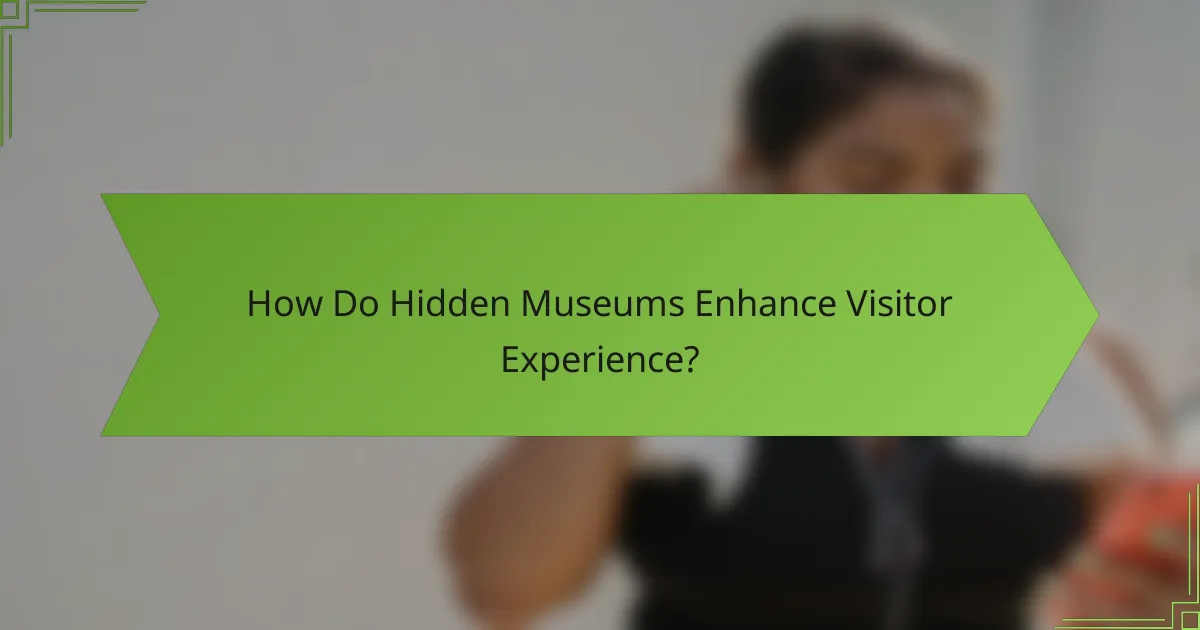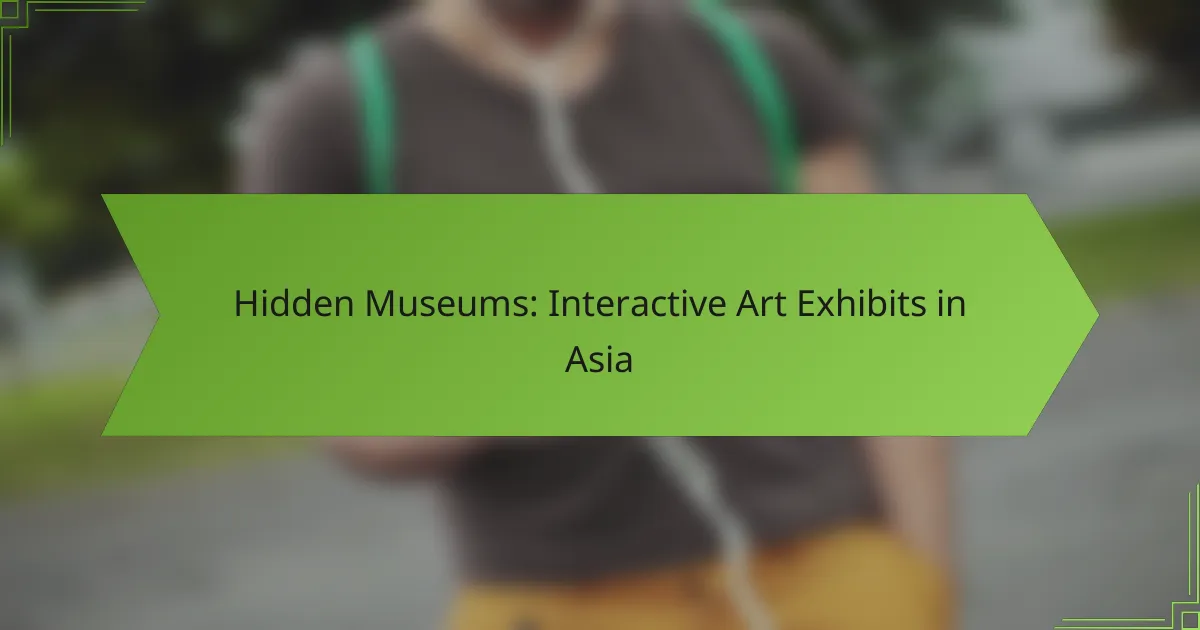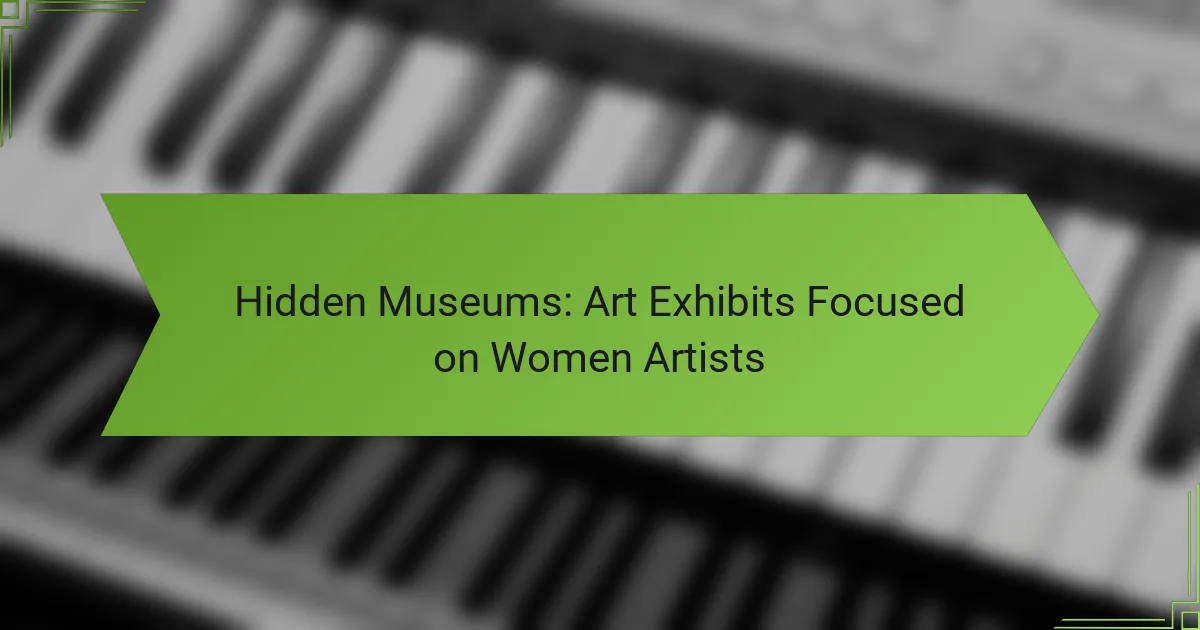Hidden museums across Asia are redefining the art experience with their interactive exhibits that blend technology and creativity. These immersive spaces invite visitors to engage with art in innovative ways, fostering personal connections and making cultural narratives more accessible. By prioritizing exploration and sensory engagement, these exhibits create memorable educational experiences that resonate with diverse audiences.

What Are the Best Interactive Art Exhibits in Asia?
The best interactive art exhibits in Asia offer immersive experiences that engage visitors through technology and creativity. These exhibits allow participants to interact with art in innovative ways, making the experience both memorable and educational.
TeamLab Borderless in Tokyo
TeamLab Borderless is a unique digital art museum in Tokyo that features a collection of interactive installations. Visitors can walk through vibrant, ever-changing environments where art and technology merge, creating a sense of wonder and exploration.
The exhibits encourage participation, allowing guests to influence the artwork through movement and touch. This dynamic interaction makes each visit a distinct experience, as the installations respond to the presence and actions of the audience.
Advance booking is recommended, especially during peak seasons, as the museum can reach capacity quickly. Tickets typically range from 3,200 to 3,800 JPY for adults, with discounts for children and seniors.
ArtScience Museum in Singapore
The ArtScience Museum in Singapore combines art and science through interactive exhibits that engage all senses. Its Future World exhibit, in particular, showcases digital installations that respond to visitor movements and interactions, creating a collaborative art-making experience.
Visitors can explore various themes such as nature, city life, and the universe, with each installation designed to provoke thought and inspire creativity. The museum often features temporary exhibitions, so checking the schedule before visiting is advisable.
Entry fees generally range from 19 to 25 SGD, with family packages available for those visiting with children. Consider visiting during weekdays to avoid crowds and enhance your experience.
Digital Art Museum in Seoul
The Digital Art Museum in Seoul offers a captivating blend of technology and artistry, showcasing interactive installations that invite visitor participation. The museum features immersive environments where digital projections and soundscapes create a multisensory experience.
Key installations often include interactive elements that allow guests to manipulate visuals and sounds, making each visit a unique journey. The museum emphasizes the connection between art and technology, encouraging creativity and exploration.
Tickets are typically priced between 15,000 and 20,000 KRW, with discounts for students and groups. To maximize your visit, consider exploring during off-peak hours, such as weekday mornings, for a more intimate experience.

How Do Hidden Museums Enhance Visitor Experience?
Hidden museums enhance visitor experience by offering unique, interactive art exhibits that engage the senses and encourage exploration. These spaces often prioritize personal connection and immersion, making art more accessible and enjoyable for diverse audiences.
Immersive Environments
Immersive environments in hidden museums create a sense of place that draws visitors into the artwork. By using spatial design, lighting, and sound, these exhibits transform traditional viewing into an engaging experience. For example, a museum may simulate a forest setting where visitors can walk through and interact with nature-themed art installations.
These environments often encourage visitors to participate actively, rather than passively observing. This can include walking through installations, touching interactive pieces, or even becoming part of the artwork, enhancing emotional connections to the pieces displayed.
Engagement Through Technology
Technology plays a crucial role in enhancing engagement at hidden museums. Many exhibits utilize augmented reality (AR) and virtual reality (VR) to create dynamic experiences that captivate visitors. For instance, AR apps can provide additional layers of information about the artwork, allowing visitors to see animations or hear stories related to the pieces.
Moreover, interactive screens and mobile apps can guide visitors through the museum, offering personalized tours based on their interests. This tech-driven approach not only makes the experience more informative but also allows for a more tailored visit, catering to individual preferences and enhancing overall satisfaction.

What Are the Unique Features of Asian Interactive Art Exhibits?
Asian interactive art exhibits are distinguished by their immersive experiences that blend technology with local culture. These exhibits often engage visitors through hands-on activities, digital enhancements, and cultural narratives that resonate with the region’s heritage.
Integration of Local Culture
Interactive art exhibits in Asia frequently incorporate elements of local culture, reflecting the traditions, history, and artistic styles of the region. For instance, exhibits may feature traditional crafts or folklore, allowing visitors to engage with the cultural context while participating in the art-making process.
Examples include workshops where attendees can learn traditional painting techniques or participate in local festivals through interactive displays. This cultural integration not only enriches the visitor experience but also promotes awareness and appreciation of the region’s heritage.
Use of Augmented Reality
Augmented reality (AR) is a prominent feature in many Asian interactive art exhibits, enhancing the visitor experience by overlaying digital content onto the physical environment. This technology allows for dynamic interactions, such as viewing 3D models of historical artifacts or animated scenes that bring static displays to life.
Visitors can use their smartphones or AR glasses to engage with the art in innovative ways, such as scanning QR codes to unlock additional information or animations. This blend of digital and physical elements creates a more engaging and memorable experience, appealing to tech-savvy audiences and younger generations.

How to Find Hidden Museums in Asia?
Finding hidden museums in Asia requires a mix of online research and local insights. These lesser-known art exhibits often rely on word-of-mouth and niche platforms for visibility, making them a treasure hunt for art enthusiasts.
Online Platforms and Apps
Utilizing online platforms and apps is an effective way to discover hidden museums. Websites like TripAdvisor and Yelp often feature user-generated reviews that highlight unique art spaces. Additionally, apps such as Google Maps can help you locate nearby hidden gems by searching for terms like “art exhibit” or “museum.”
Social media platforms, especially Instagram, are invaluable for finding interactive art exhibits. Many artists and museums post updates and events, allowing you to follow trends and discover new locations. Look for hashtags like #HiddenMuseum or #InteractiveArt to find posts from visitors.
Local Recommendations and Guides
Local recommendations can be one of the best ways to uncover hidden museums. Engaging with residents or local art communities often leads to discovering places that are not widely advertised. Consider visiting local cafes or art supply stores where artists gather; they can provide tips on lesser-known exhibits.
Guided tours focused on art and culture can also reveal hidden museums. Many cities in Asia offer specialized tours that include off-the-beaten-path locations. Check local tourism websites for options that highlight unique art experiences, ensuring you don’t miss out on these interactive exhibits.

What Are the Pricing Models for Interactive Art Exhibits?
Interactive art exhibits typically utilize various pricing models, including general admission fees and membership options. Understanding these models can help visitors choose the best way to experience the art while managing costs effectively.
General Admission Fees
General admission fees for interactive art exhibits can vary widely, often ranging from around $10 to $30 per person, depending on the location and the complexity of the exhibit. Some larger or more renowned exhibits may charge higher fees, especially in major cities like Tokyo or Seoul.
It’s common for these fees to include access to all interactive installations, but some exhibits may offer additional experiences for an extra charge. Always check the exhibit’s website for any special pricing on weekends or holidays, as well as discounts for students or seniors.
Membership Options
Many interactive art exhibits offer membership options that provide benefits such as unlimited access, discounts on special events, and exclusive previews of new installations. Membership fees can range from $50 to $200 annually, depending on the institution and the level of benefits offered.
Choosing a membership can be cost-effective for frequent visitors, especially if you plan to attend multiple exhibits or events throughout the year. Consider the value of the benefits against the membership cost to determine if it’s a worthwhile investment for your art exploration.

What Are the Future Trends in Interactive Art Exhibits?
Future trends in interactive art exhibits are increasingly focused on technology integration, particularly through artificial intelligence and virtual reality. These advancements enhance visitor engagement and create immersive experiences that redefine how art is perceived and interacted with.
Increased Use of AI
The incorporation of artificial intelligence in interactive art exhibits allows for personalized experiences that adapt to individual visitor preferences. AI can analyze visitor interactions in real-time, adjusting the exhibit’s elements to enhance engagement and emotional response.
For instance, AI-driven installations can modify visuals or sounds based on the audience’s reactions, creating a dynamic environment. This trend not only enriches the visitor experience but also provides artists with valuable data on audience engagement.
Virtual Reality Experiences
Virtual reality (VR) is transforming interactive art by offering fully immersive environments where visitors can explore and interact with art in unprecedented ways. VR experiences can transport users to different worlds, allowing them to engage with art pieces from unique perspectives.
Exhibits utilizing VR often include headsets that enable users to step into a digital realm, where they can manipulate art elements or even create their own art. This trend is particularly popular in urban areas across Asia, where tech-savvy audiences are eager to explore innovative artistic expressions.



